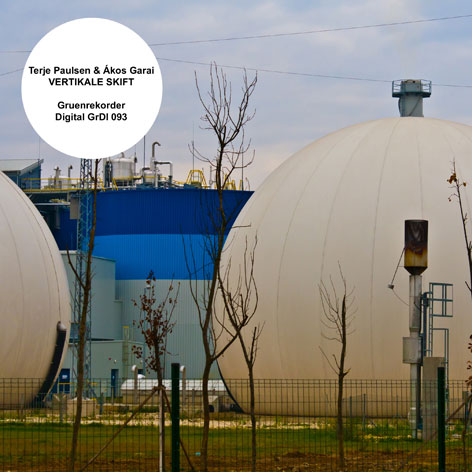Vertikale skift. TERJE PAULSEN, ÁKOS GARAI
(Gruenrekorder 2011)
Terje Paulsen and Ákos Garai are both widely known artists whose work is formally very different: the sound of Terje Paulsen is more artificial while the sound of Ákos Garai is more natural and phonographic.
On the notes for the release it reads: “Tracks 1,4,5,7,8 recorded and composed by Terje Paulsen August 2010. Tracks 2,3,6,9 recorded and composed by Ákos Garai September-October 2009. This album edited, compiled and mastered by Ákos Garai October 2010”
From the notes (written by Christopher McFall) it’s unclear how involved each artist was on the other artist’s piece but when you listen the whole release together there is a formal unity that creates an ambiguous sonority where the artificial and the natural exposes the tension between reality and fiction. What is quite interesting here is how the listener experiences artificial / processed sounds and field recordings when juxtaposed.
The sounds used by Ákos Garai are captured but they have this abstract nature that sometimes make them impossible to link to its causality: they drive the listener right to his reduced hearing where sound build this objects made with sound and nothing else.
In the other hand the sounds of Terje Paulsen although processed, present this environmental nature that the listener could easily link with “things” such as machines, wires and insects; the relation between the casual and reduced hearing becomes more complex exposing some tendency (at least on me) to give visual properties the sound object.
When the sounds of dropping water appear on Waterworks II (piece number two) the tension / balance between the artificial and the natural becomes quite strong, the listener now listens to familiar sounds placed in an unfamiliar context, sort of like water leaking on a spaceship: the poetical value of this image explores the strong poetical value of Ákos Garai and Terje Paulsen working together, combining their methods, processes and perceptions to build a sound universe of deep artistic transcendence.
“Vertikale skift” is a great example of how sound and in particular the sound object can create this amazing link between fiction and reality, of how sounds from our daily life can become universal in both senses of the word: universal in regard to the sound perception that we have of the cosmos, and universal in regard to something that is common to all.
When exposed to the sound object the process of imagine becomes the bonding element between the individual listener and the listened sounding universe; the capacity to reduce when exposed to sound is what establishes this universal sense of the cosmos; the listener is linked to the universe he is part of and the containing universe is linked to the listener through the sensible experience that is general and specific simultaneously. It’s the cosmos listening to itself through the listener and the listener listening to himself through the sounds around him, through the universe he is part of.
“Vertikale skift” is a publication that not only rewards the listener with a meaningful experience but that also reveals pertinent and relevant questions and reflections in regard to the experience of listening in an artistic and phenomenological level.
-John McEnroe
Ákos Garai website
Terje Paulsen website
Gruenrekorder website


